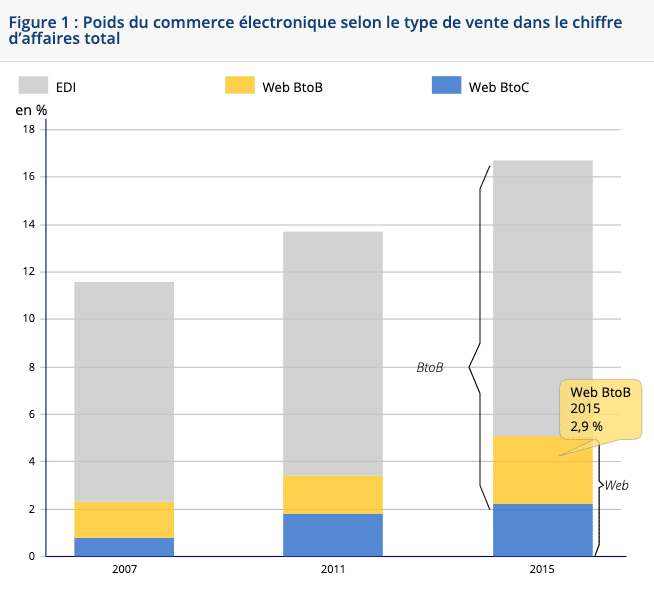Unlike “B2C” e-commerce, short for “Business to Customer”, which is aimed at private individuals, “B2B” e-commerce, or “Business to Business”, is aimed solely at business customers.
Sales techniques are therefore different, and this has a major impact on the way we do business and the technical solutions we implement.
There are a number of aspects to consider when developing your B2B e-commerce business.
The specifics of B2B e-commerce
The right marketing strategy
Since B2B e-commerce is aimed at professional customers, the communication approach will not be the same as for B2C.
Professional customers generally know exactly what they’re looking for.
They’ll try to obtain the product(s) they need, as easily as possible and at the best possible price.
So you can’t rely on a marketing policy designed to trigger an impulse purchase.
The professional customer will have thought carefully before placing an order, and will have taken the time to compare your offers with those of your competitors.
Your marketing communication will therefore have to offer customers the products they are looking for, and make them as easily accessible as possible. 
A different pricing policy
You can’t apply the same pricing policy to B2B as to B2C.
The reason is simple: in B2B e-commerce, you’ll be dealing with bulk orders.
If you sell stationery, your customers won’t be ordering reams of sheets individually or in cartons, but in whole pallets.
The principle in B2B is generally to offer sliding-scale prices according to the quantity ordered.
This not only enables you to obtain larger orders, but also to propose specific commercial offers to each customer.
It’s a good way of strengthening your ties with your customers and building loyalty.
Wholesale orders
In B2B e-commerce, you’re mainly dealing with wholesale orders.
The scale is totally different from B2C sales.
This directly involves your business, especially if you sell physical products.
The problem is very different if you sell dematerialized products or services.
If you have to manage large orders for physical products, you’re going to have to keep a very close eye on your inventory (you need to efficiently manage the quantities ordered, the space required to store the products, their handling, etc.), as well as your deliveries.
Shipping and tracking a parcel by post is not the same as shipping a container weighing several tons by ship.
Specific customer relationship management
In B2C, you’ll be dealing primarily with individuals.
It’s a little more complex in B2B, since you’ll be dealing with companies.
Most of the time, you’ll have a single point of contact if your customers are small businesses.
The accounting or purchasing department, where it exists, will handle negotiations and orders.
Your contact within the company will change very little.
On the other hand, you’ll have several contacts in different departments if you’re working with larger companies.
Customer relationship management is therefore not quite the same.
It’s hard to build customer loyalty in B2C.
Most will buy once and then disappear.
You’ll need to forge genuine partnerships with your corporate customers.
It’s all about forging long-term customer relationships and establishing a bond of trust.
You’ll need to tailor your service to each customer’s specific needs.
Growth in international B2B e-commerce
E-business is also an easy way to expand internationally.
Take a look at this video on the challenges of international B2B e-commerce:
What tools are needed for a successful B2B e-commerce development strategy?
More personalized customer accounts
You don’t treat a business customer like an individual.
A corporate customer may have several registered users on the B2B e-commerce site.
Each user may have a specific role and rights, and often belong to a different hierarchy or department.
It is therefore essential to be able to manage these different users with different profiles, and for the site to adapt accordingly.
This hierarchy of users linked to the same company must be reflected on the site.
Buyers, for example, need to be able to create personalized product lists, compare prices or request quotes.
Purchasing managers, on the other hand, will have access to additional functionalities such as orders and invoices.
A personalized catalog with customized prices
In B2B e-commerce, you’re not going to offer the same products at the same prices to all your customers.
It’s important to know every company you work with.
You’ll need to adapt your catalog to suit your different partners and contacts.
The products of greatest interest to each customer will be highlighted, and prices adjusted.
Pricing depends on a number of criteria.
Depending on the volume purchased by a customer, the regularity of his orders, or any negotiated discounts, catalog prices will vary.
This means managing different price lists for each customer.
Even if the B2B e-commerce solution you’re using has this functionality, you’ll need to ensure that all this information can be transmitted to your ERP system.
Simplified interaction and communication
Detailed product information is essential for B2B buyers.
So it’s important that you can add as much consistent product information as you need.
The B2B e-commerce platform must have content management functions (CMS).
In this way, your marketing team will be able to directly edit content and product descriptions.
They can add photos, videos and any other information they deem relevant.
The advantage of a CMS is that the marketing team is entirely independent.
No technical intervention is required.
Similarly, it’s a good idea to allow buyers to send inquiries or requests for quotes directly and, above all, easily to the salespeople in charge of the products.
This facilitates communication with your customers.
B2B e-commerce trends
Everyone agrees that B2B e-commerce is on the rise.
Just three years ago, one-fifth of companies made paperless sales, but more than one in two made paperless purchases (Source).
Computerized processes facilitate transactions.
B2B e-commerce sales even outstripped B2C e-commerce sales, accounting for 2.9% of sales versus 2.2%.
Industry accounted for just over half the market (55%), followed by trade (32%) and services (12%). 
Buyers have had to adapt and transform their behavior.
Sales are likely to reach record levels again in 2021.
Marketplaces are multiplying.
If they were already well established in B2C, they are now also breaking through in B2B.
This gives sellers greater visibility and makes it easier for buyers to compare.
User experience is also becoming increasingly important.
B2B buyers have no time to lose and want an application optimized for them.
Processes need to be fluid, and suggestions, recommendations and promotions need to be tailored and personalized.
Customer experience is undoubtedly the key to B2B e-commerce success in 2021.
Your B2B e-commerce solution
I’m here to help you with your B2B e-commerce projects, from the initial idea phase right through to going live, and even beyond if you wish.
With many years’ experience in web development and as an e-commerce expert, I’ll put my skills at your disposal to ensure that your transition to B2B e-commerce goes as smoothly as possible. Contact me today to discuss your requirements.


